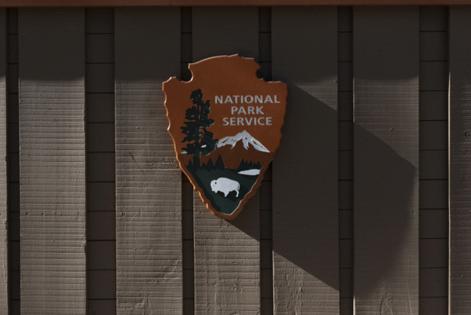Grand Canyon fire is new blow to Park Service hit by staff cuts
Published in News & Features
The wildfire that destroyed a historic lodge on the North Rim of the Grand Canyon this month was the latest blow to the struggling National Park Service after months of staffing and funding cuts under the Trump administration.
Since President Donald Trump took office, the Park Service has lost more than 4,000 full-time employees to layoffs and buyouts, reducing the agency’s permanent staff by 24 percent, from 16,655 in January to around 12,600 in June, according to Interior Department data obtained by the National Parks Conservation Association, an advocacy group with more than 1.6 million members.
The group said the number of seasonal workers is around 5,400, short of the 7,700 that Interior Secretary Doug Burgum said would be hired for this year’s busy season.
The reduced workforce has damaged staff morale and diminished many visitor experiences, and there is more to come for the system sometimes referred to as “America’s Crown Jewels.”
The National Park Service said in an email Friday that it “is focused on ensuring that every visitor has the chance to explore and connect with the incredible, iconic spaces of our national parks.”
The Republicans’ “big, beautiful” budget reconciliation bill passed by Congress this month eliminates $267 million that had been allocated for the Park Service by the Biden administration’s tax and climate law, an amount that could have gone toward hiring new personnel, according to the NPCA.
And the House version of the fiscal 2026 Interior-Environment Appropriations bill would cut the Park Service budget by $213 million, to $3.1 billion, according to a Republican summary of the legislation.
“The administration has created a crisis within the National Park Service as skeleton crews of what staff remain struggle to protect resources and ensure visitors have a safe and inspiring time in our parks,” said John Garder, senior director of budget and appropriations at the NPCA.
“And the threat only keeps getting worse as members of Congress agree to cut hundreds of millions more dollars for national park staffing between the recent big budget bill and now the House’s annual appropriations bill,” Garder said. “We’ve never seen this level of public outcry, and it’s past time that Congress and the president listen to Americans and stop undermining our parks and their rangers.”
The Park Service manages the 63 national parks and 370 other units, including monuments, memorials, battlefields, national seashores and historic sites. There were more than 330 million visitors last year.
“Communities around the parks are very dependent upon visitors coming, and yet our employee levels continue to drop,” said Phil Francis, chair of the executive council at the Coalition to Protect America’s National Parks, made up of more than 4,400 current, former and retired employees and volunteers of the National Park Service. “It doesn’t make sense. I mean, if there was some way to use technology to reduce the number of employees, maybe that would make a little bit of sense, but not much.”
Francis, a 41-year veteran of the Park Service, said most of the work done by park rangers and employees is “one-on-one with visitors who have a whole wide variety of questions,” as well as rescuing stranded hikers or helping orient visitors so they won’t get into danger. Now many of those employees are also doing maintenance and custodial work such as cleaning bathrooms, and “that means poor service to the public,” he said.
After the Supreme Court this month lifted a lower court injunction blocking the president’s orders for deep cuts in the federal workforce, the coalition, the NPCA and two other groups — the Association of National Park Rangers and Public Employees for Environmental Responsibility — released an analysis of staffing cuts so far at the Park Service.
Among the findings: All 13 lifeguard positions are vacant at the Assateague Island National Seashore in Maryland and Virginia, and three units of the national parks in Boston, which are hosting events celebrating “America 250” all year, have more than 50 vacancies, including a superintendent, deputy superintendent, interpretive park rangers and a museum curator.
“One of our fundamental missions is to protect and conserve the natural and cultural resources and the wildlife therein,” said Francis. “But you know, when we cut staff sort of arbitrarily, and the staff is being cut by people who really have never worked in a park, it sounds to me like we’ve got a conflict in missions and roles. On one hand, we’re supposed to do everything we can to serve the public and protect the resources. On the other hand, the Congress is taking that ability away, and that’s going to have a big impact on communities.”
Meanwhile, the costs to rebuild the 98-year-old Grand Canyon Lodge and dozens of surrounding structures, including a visitor center and Park Service offices and housing, burned in the still-raging Dragon Bravo Fire in Arizona is expected to be in the hundreds of millions of dollars, adding to an enormous backlog of maintenance needs in the park system.
The destruction is just another example of the effects of climate change on the national parks, said Francis, whose coalition along with the Sustainable Energy and Environment Coalition Institute issued a report last week describing some of those impacts.
“From coastal erosion in Acadia and the Everglades to ecosystem collapse in Yellowstone and increasingly intense wildfires in Yosemite, Rocky Mountain, and Shenandoah, the climate crisis is leaving no place untouched,” the groups said in a news release about the report.
“You know, one of the things about the parks is they provide sort of a baseline,” Francis said. “It’s a place where you can do scientific study to see what the impacts of global climate change are, right? And some of the people who’ve been cut are those very people who do the analysis.”
_____
©2025 CQ-Roll Call, Inc., All Rights Reserved. Visit cqrollcall.com. Distributed by Tribune Content Agency, LLC.







Comments